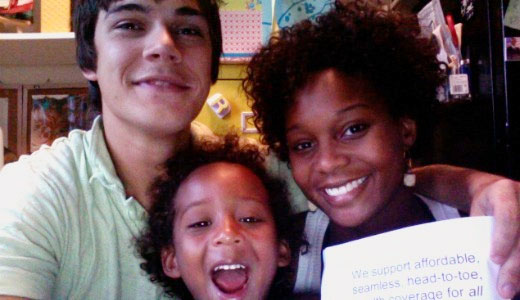
The recession hasn’t been good for anyone, but children have been especially hard hit, even “over the past year, as the country slowly climbs out of the recession,” says a new report by the Children’s Defense Fund.
Child poverty dropped 27 percent between 1992 and 2000, the report shows, but went up 28 points between 2000 and 2009.
The problems facing children, CDF President Marian Wright Edelman wrote, are “the greatest threat to America’s national security.”
The report, titled “The State of America’s Children 2011,” paints a dire picture, with particular emphasis on “children of color in America who now constitute almost 45 percent of all children, and will be the majority of children in 2019 – just eight years from now.”
More than a third of Latino and black kids, and a tenth of white kids, live in poverty. For the newest generation, those under the age of five, the poverty rate is even worse: 41.9 percent of black, 35 percent of Latino and just under 15 percent of white children are in poverty.
80 percent of black and Latino students in public schools and around half the white students aren’t able to read at their grade level. And while 81 percent of whites graduate high school eventually, only about 60 percent of black students do.
Unemployment rates for teens 16-19 years old were higher in July 2010 than at any point in the past 50 years.
Income has become more unequal for all Americans over recent decades, taking a toll on young people: “In 2008, the income share for the richest 10 percent of U.S. households was 48.23 percent, just slightly below its 2007 record high level of 49.74 percent. The average income for the bottom 90 percent of households in 2008 was at its lowest level in more than a decade. The one-year income drop for this group in 2007-2008 was its largest since 1938.”
At the same time, by 2009, welfare payments were less than half the 1970 real dollar amount, while Medicare and SCHIP fail to make up the gap for poor kids: “One in eight black children and one in six Latino, children are still uninsured. Two-thirds of the more than eight million uninsured children are eligible for coverage in Medicaid or CHIP but are not enrolled largely due to state-imposed barriers that differ across states,” the report said.
Underfunding of social services budgets seems to have endangered the physical safety of children: “About 40 percent of children who were abused or neglected in 2009 received no services following the investigation of their maltreatment and many more received far fewer services than they need.”
“This may be the first time in our history when our children and grandchildren will be worse off than their parents and grandparents,” Edelman continued, after making the case that all Americans have a stake in children’s welfare.
“Isn’t it better to have them supporting the Social Security and Medicare systems and making sure a productive workforce is in place, rather than for us to be supporting them in costly ineffective prisons?” she continued. “Our states are spending three times more on average per prisoner than per public school student. I can’t think of a dumber investment policy.”
With a list of statistics, the report makes the point that the U.S. could provide far better for its youth. According to the report, the U.S. ranks first in GDP and the number of billionaires, last in relative child poverty, last in protecting kids against violence and 30th in infant mortality rates.
Also, while the U.S. could put more money to alleviating poverty, the statistics also suggest that more rational spending of the same money could benefit young people: The U.S. ranks first in student expenditures, even though it ranks 31st in math scores and 17th in reading scores.
Photo: Children’s Defense Fund












Comments